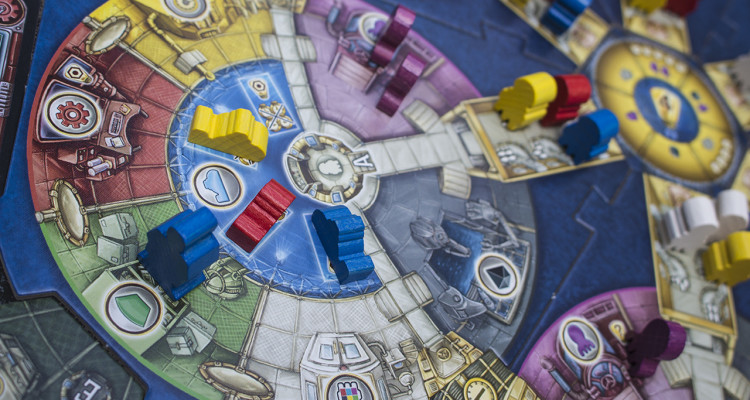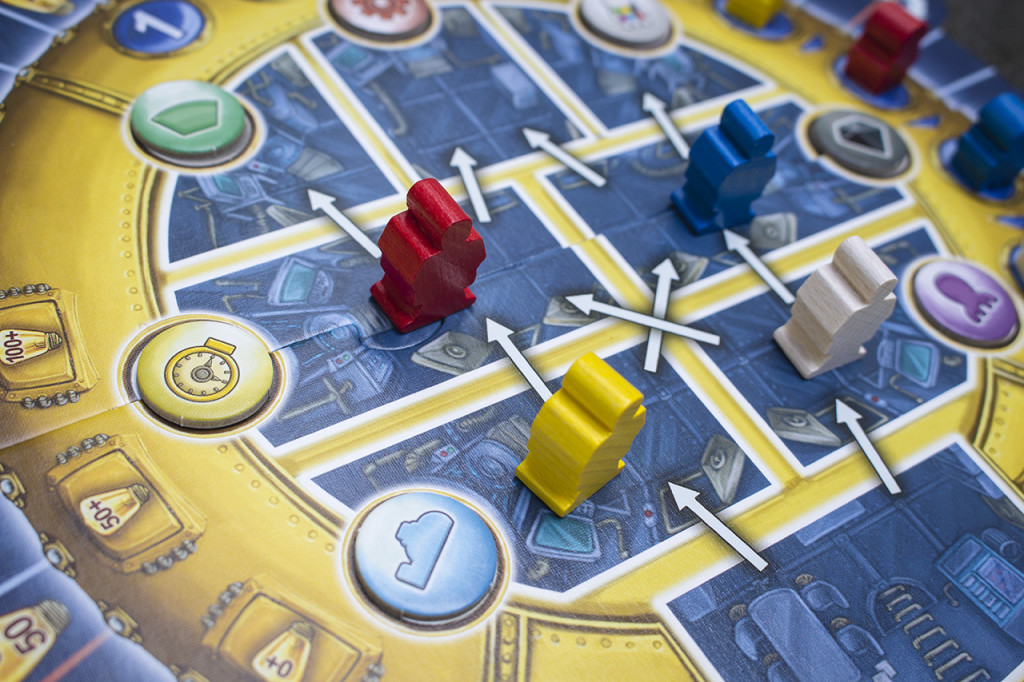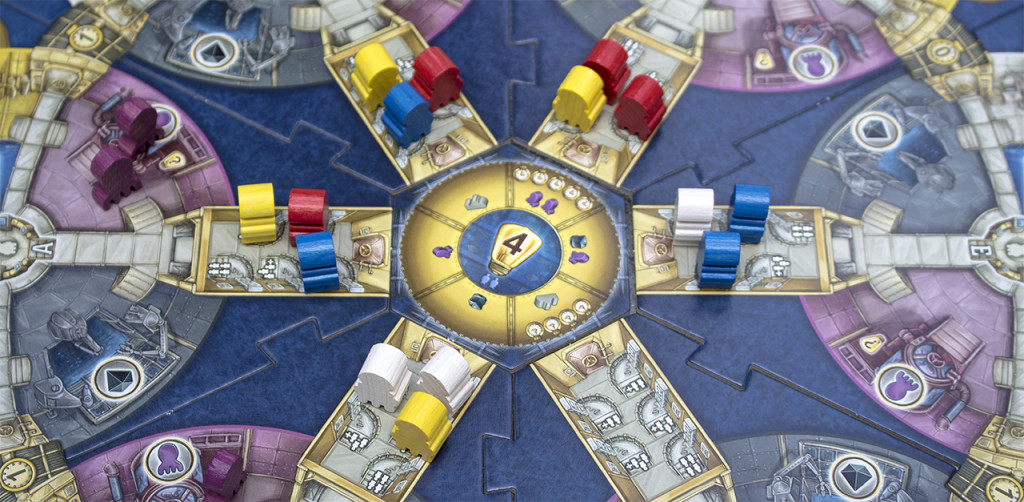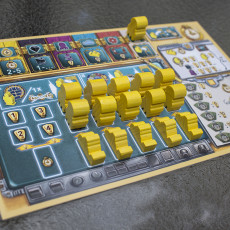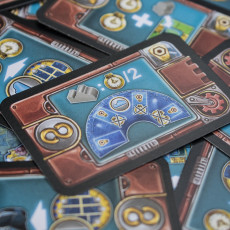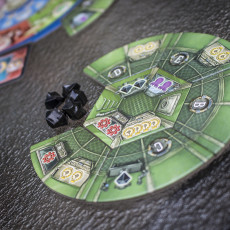Welcome to the S. Feld Deep Sea Geological Laboratory, operating name: ‘The AquaSphere.’ You are here for one reason, and one reason only: to investigate the unusual mineral substance located in the surrounding waters, analyze its uses and purposes, and recover as many samples as possible before your contract closes. There isn’t much time, but that’s why you were chosen. You are here because of your expertise and suitability for the challenging environment.
Prove that our choice was the correct one.
… Oh, and one last thing, do watch out for the octopods.
AquaSphere, the latest endeavor from designer Stephan Feld, is a worker placement and action selection game for 2-4 very brave individuals. Your objective is to score the most Knowledge Points (KP) by carrying out various actions throughout the AquaSphere Research Station. To do the heavy lifting, you will be programming robots in order to complete tasks and investigate a vein of black crystal found deep underwater. All that said, I take the liberty of interpreting the tone of the game however I please because, as you’ll quickly realize, AquaSphere is a mechanics-first mental exercise that emphasizes optimization and efficiency over flavor and storytelling.
A Whole Lot of Moving Pieces
The basic layout of AquaSphere involves two communal boards, while each individual also gets their own player board and a bare-bones research lab to start off with. The first of the two, the Programming Station, doubles as a score track and will list your potential programming options in a 2-2-3 flowchart. You’ll use this board to dictate what actions you’d like your bots to do in the future. The second communal board, the AquaSphere itself, is made of 6 identical petals that interlock to form a round board. Each separate piece has spaces for the 7 available actions, a loading station, and a lock connecting it to the piece on either side. It is here that you’ll be placing your bots, executing actions, and jockeying for control of certain areas. Your personal player board holds your unused bots and submarines, has programming icons to delineate which bot is programmed to which action, and includes all of the referential information you will need for intermediate and end of game scoring. Finally, your personal research station acts as your supply, dictating how many of each resource you can store / interact with. Whew!
What To Do and How To Do It
The basic turn structure in AquaSphere is simple. On your turn, you have 3 options: program a bot, move and execute an action, or pass. To get anything done in the AquaSphere, you’ll need one of your mechanical drones to do it for you; but first, you’ll need to tell them what it is you’d like them to do. To program a bot, you’ll advance your researcher one step towards the top of the Programming Station. The first two levels of the Programming Station force you to choose between two possible actions, while the third level contains three. The real kicker is that due to the layout of the Station, your choice of the second level action will lock you from one of those third-level actions. This forces you to evaluate the opportunity cost of taking one action over another on the previous level. Thus begins the analysis loop…
Once a bot is programmed, they are stored in the proper section of your player board, and you may put them to work in one of the six sections of the AquaSphere on a later turn. Each section has the same action options available, but the specific benefit of an action in one section will be different from the benefit in another. For instance, removing octopods will always give you points, but this scales based on the amount of octopods you remove in a single action, and each section will generate a different amount from round to round. Similarly, station upgrade cards can be found in each section, but their order is random each time. This adds more cogs to the machine, forcing you to consider the “when and where” of each action. This is pressurized though, by the limited amount of time you have to work with. Each game only lasts 4 rounds, and you’re only guaranteed 12 free programmed bots for the entire game. Sure, there are ways to acquire additional actions and change the rules a bit, but this crunch – this tension – will likely never be alleviated.
The Crystallizing Moment
While there are plenty of finer points within the rulebook, the rest of the game is better explained within a broader discussion of potential successes and failures. Anyone looking to AquaSphere for a gaming experience will find a level of design complexity and depth of choice that is equal to, if not slightly higher than, the other titles in Feld’s catalog. While the rules themselves are sensible once put into practice, simply doing anything in the game feels difficult. This may be compounded by the fact that, after many plays, it appears you need to do everything – at least to some degree. In my plays of AquaSphere, winning the game has been a matter of perfecting an efficient point-generating engine based on a rapidly changing board composition; however, simply surviving AquaSphere requires a very similar level of attention to detail.
Two particular aspects of AquaSphere that stand out are the black crystals and the scoring structure. The black crystals, as you will come to find, are the single most important piece of the AquaSphere puzzle because you cannot score points without them. Well, technically you can score 12 points without them, but the point I’m making alludes to four tiny red lines found in 12 point increments on the scoring board. These are thematically nonsensical “score walls,” which will prevent you from scoring unless you pay one black crystal or deprogram one of your precious bots the moment you hit the wall. This means that the most carefully executed plan is all-for-naught if you do not also incorporate some crystal gathering. I’ve found that no matter how many times I emphasize this point while teaching, somebody inevitably lashes out when they “score” 10 points, only to be stopped in their tracks 7 points short for not paying the crystal toll. It’s painful, but the easy answer would be to focus on crystals, right? That would be true if you didn’t then have to worry about increasing your lab size to accommodate more crystals, fight your friends for those precious black gems, and avoid getting your head devoured by an ever-increasing army of little purple octopods that can cost you upwards of 21 points in a single turn (which, adding insult to injury, will push you backwards across one (or more) of those little red lines…)
If you can manage to accrue a small stockpile of crystals, you can then turn your attention to the rest of the game. But… good luck in deciding on what next to do. What can be its biggest strength or weakest link is the lack of direction provided by AquaSphere. You have no starting “goal cards” or special player power, so there’s nothing to suggest where to go in this multicolored mess. This means that you can probably determine whether or not you’ll like AquaSphere by asking yourself how much you enjoy sifting through a game searching for the perfect strategy versus being pushed in a certain direction. Everything you do will score you points, sure, but will it score you the most points possible? Should you build toward destroying octopods each round for big points, or should you sacrifice a few bots building submarines to get a more stable benefit in the future? Ah, but the end-game bonus for research stations is huge and it’s not subject to the little red lines! Maybe you should just put out a bunch of bots and win the area control battle, plus the points from simply placing bots anywhere. Oh… but, wait… you only have one bot left anyway and… you don’t have any crystals. *sigh* Maybe next game?
Final Thoughts
AquaSphere is a smart game. It has strategic depth, game-to-game variability and an ever-changing series of options to navigate each round. It also feels familiar to a seasoned Feldian. It’s more of an amalgamation of old thoughts brought to life in a new and unique way. But…is it fun? Is it something you’ll be excited to sit down and play? I suppose that depends on how much of a glutton for punishment you are.
Like many of Feld’s other games, AquaSphere is a blend of mechanical components that can be accessed through a range of action options; and, like many of these games, the nature of the design restricts you – limits you – in a way that makes every decision essential. The overall idea of this design is to present more options than can be appropriately addressed in the time-frame of the game; but, rather than use this as a tool to have you narrow your strategy, Feld turns this euro-style game up to “11” by making all of those options important and requiring your attention.
I have heard from different sources that AquaSphere feels like the complexity was forced – that it has one or two too many layers that don’t have relevance or the need for inclusion – but, I’ve found that everything in this game has its place. This doesn’t mean that it wouldn’t work in a more streamlined fashion; it could easily have some of its components stripped away to make for a cleaner feeling game, but I don’t think it would be the same. Once you’ve played enough to realize and accept that some things need to be accomplished before others and that you’re largely on your own, the game can feel incredibly rewarding to conquer. That may not be sought after by everyone though, and even if you have a great game, there’s little guarantee that what you’ve achieved this time will even be possible next time.
AquaSphere is a strong showing in the euro-style market that is largely cast within the shadow of its designer’s previous work. It feels weaker in comparison to its brothers but can stand firm as providing an enjoyably agonizing experience that will bear more fruit with repeated plays and a better understanding of its parts.
The League of Nonsensical Gamers would like to thank Tasty Minstrel Games for kindly providing us with a copy of AquaSphere for this review.
League Ruling
Matt
Seeing as I wrote the above review, I think my thoughts on AquaSphere are clear. I’ve found from my plays that AquaSphere is a tough but rewarding experience and one that will get better over time. I agree with my peers that it’s not an instant-classic like many of Feld’s other titles, but it pulls its inspiration from many of those other games; for that reason, AquaSphere provides an enjoyably familiar experience to the seasoned gamer, while simultaneously shattering the common conception of euro-style games for those less exposed to the genre. I think this one is definitely worth a play and you’ll know shortly after starting whether or not it’s worth a purchase.
Smee’s Two Pence
Such sweet and sublime torture. A delicious agony of indecision, self doubt, and despair. All of this awaits you in Stefen Feld’s AquaSphere. You want to talk about choices? You haven’t made a choice until you find that you need a crystal to score, but the room it’s in is flooded with octopods, and the octopod-killing action is completely on the wrong side of the programming station, and your submarine is leaking and the robots have gone haywire and oh god why are there squid eggs everywhere?
I can only award half a thumb, not because it’s a bad game, but because it gives me a headache every time.
Kelly B
The first time I played AquaSphere, I was so unbelievably frustrated that I considered not ever playing again. It took forever, I felt totally clueless and I was fuming. Once we worked out all of the kinks in the rules, I needed to play it again because I was determined to play it better. I’m almost positive that every time I’ve played this game, it’s been frustrating. I finally gather the resources so that I can dock a submarine and someone else docks their submarine first and now I’m short on resources again; the only two actions I was hoping to take in a round are next to each other in the programming station and I can only pick one of them; or someone just collected the octopods I’d been eyeing up. “Whatever!”
AquaSphere gives you about a billion options to collect points and your opponents are bound to screw up every one of them for you at some point or another. This game is challenging. Once you understand everything you can do, it’s much easier to grasp, but the internal struggle remains as you’re constantly forced to choose actions at the expense of others. With all of that being said, I like AquaSphere. I get mad as hell while I’m playing the game, but I like it. As for the components, the bright colors, fun meeples, and underwater station pieces that fit together like a puzzle are awesome. Those octopod meeples are just so dang cute!
Dan
My name is Dan and I am a Feldian. That feels good to get it off my chest! Feld is a master at weaving many moving pieces into a coherent experience that plays out like a complex puzzle full of difficult decisions and scarcity among resources and actions. This is the number one reason I am such a fan of his designs – I find these core concepts endearing. However, never has one of his games frustrated me like AquaSphere. And after multiple plays I still cannot put my finger on “why?!”
Maybe it’s the “complex for complexity’s sake” feeling I get as I score points only to find that they are lost because I am short black crystals? Maybe it’s the fact that while traversing the board time seems to slip into the future faster than Seal? Or perhaps it’s the fact that not only can the game and my opponents screw me but I can just as easily screw myself by mis-programming my bots in the long run? I have experienced all of this in other games, even other Feld designs, but for some reason AquaSphere just doesn’t click for me. All of that said I still find it an intriguing and well designed game at its core. Like the depths of the seas in which the game is set, the farther you are willing to journey in to the game, the more it reveals. At the end of the day though, if I’m looking for my mind to go around in circles, I’d rather pull out Trajan.
Ben
AquaSphere is a rather tactical game, which helps me enjoy it a lot. I prefer tactical to strategic games, since I tend to be better at reacting to immediate situations then long term strategic planning. You can try to have an overall strategy in this game, but you will inevitably get screwed over by another player or the game itself and have to adjust. I love this about the game. I think it’s important to note that, while you may have been screwed over, I always felt like I could do something. It was very much a, ok I’ve been screwed out of what I wanted to do… what is my best move now, type of game… aka tactical.
The above thoughts came to me after one play with 4 players. I then got a chance to play it 2 player and enjoyed it even more. It played very quick and it was mostly a game of who could beat the game the best. We didn’t really interact too much with each other, but there was just enough with majority and some of the cards that we were both going after to keep it interesting. This is another Feld that I prefer with fewer players. I get the sense that, like with most other Felds I’ve played, it will be perfect with 3 players.
Steebin
While I’ve only had a single play, I’ll lend my first impressions. The theme and components of AquaSphere…tractor beam. Sucked me right in. I read the campaign, read the rules, watched videos and I just could not grasp what was happening at all in this game! There are so many moving parts and a very beefy setup. None of this, however, killed my interest in the game. After watching a few more “how to play” videos and Matt quickly explaining, it was time to dip my toe in the water. With bots and technicians in hand, I was ready for the challenge that is AquaSphere. Once you dive in to the game and get your first turn under your belt, it really ends up being kind of simple. This card goes here and does this, this robot goes here and does that. The overwhelming amount of moving parts integrate very well but it’s pretty hard to achieve the goals you set out to accomplish.
I wasn’t overly crazy about my initial experience, but I was ready to try it again with a better understanding of the gameplay. Problem was, I made the mistake of trying to teach my wife. As I was setting things up and going over everything, her eyes just crossed and glazed over very quickly. We did not finish the game, unfortunately, and I have not had a chance to play it again since. I would welcome another play at any time but it is slowly falling down the list for me.

